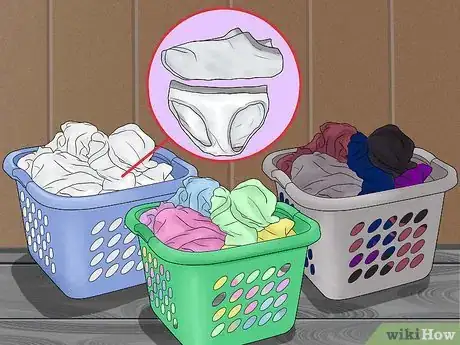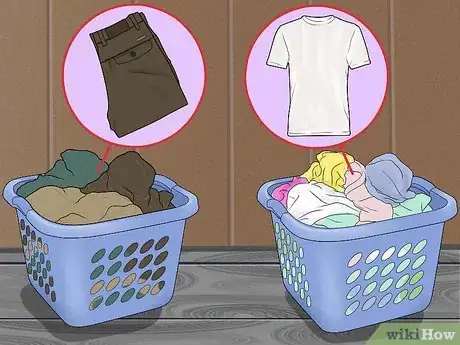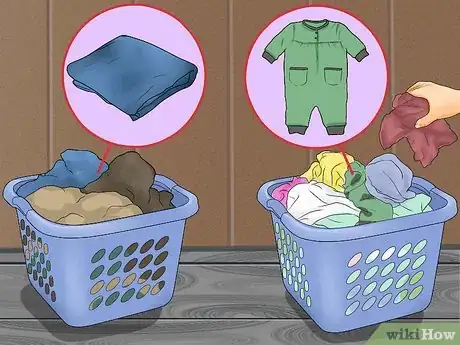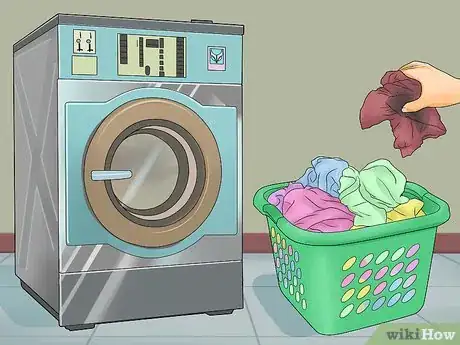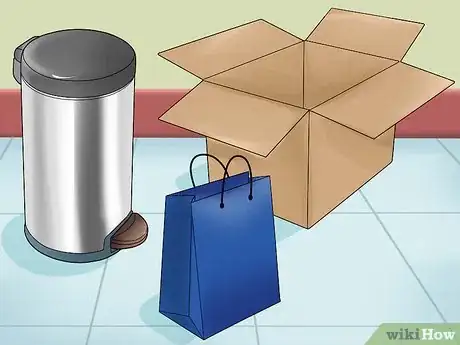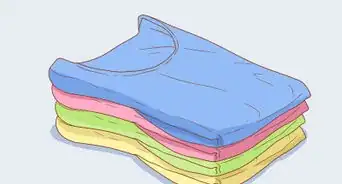This article was co-authored by Susan Stocker. Susan Stocker runs and owns Susan’s Green Cleaning, the #1 Green Cleaning Company in Seattle. She is well known in the region for outstanding customer service protocols — winning the 2017 Better Business Torch Award for Ethics & Integrity —and her energetic support of green cleaning practices.
wikiHow marks an article as reader-approved once it receives enough positive feedback. In this case, 94% of readers who voted found the article helpful, earning it our reader-approved status.
This article has been viewed 378,996 times.
Laundry is a necessity in life. Clean clothes can keep people looking and smelling nice and maintain the quality of the articles. But many people are not aware that there are safer and more effective ways to do laundry than simply throwing clothing into the washing machine. One of the best things you can do for your laundry is to sort it before washing. This can protect your clothing from damage and make for better, more efficient washing.[1] By categorizing laundry items and streamlining your laundry organization, you can easily sort laundry.
Steps
Categorizing Laundry Items
-
1Check each item. If your laundry is in a giant pile, it’s a good idea to check each item as you sort it. This gives you a chance to make sure that a red sock doesn’t end up coloring your beautiful whites and see if articles have special laundering instructions.
- Make sure to read the care instructions on each article of clothing the first time you wash it. Look at it again during the sorting process in case you forgot the care instructions or to see if you can put the item with other articles.
- Consider checking each item you’ve sorted as you put it into the washing machine to prevent mishaps.
-
2Separate by color. The first category by which you should sort is color of the items. This can prevent dye transfer problems during washing that often ruin or damage white or lighter colored clothing.[2]
- Make piles for white, light, and dark clothing.[3] Your white pile should be for articles like socks, underwear, t-shirts and other sturdy white cotton items. The light-colored pile should have colors like pink, lavender, light blue, light green, and yellow. Finally, your dark pile should have gray, black, navy, red, and purple articles.
- Consider separating out denim into its own pile. You can either wash this as an individual load or together with your dark pile.
Advertisement -
3Sort by fabric weight. Chances are that you have items made of different fabrics and textures. Sorting these out after you’ve put the articles in color piles can ensure everything from the quality of your delicates to preventing lint from sticking to certain fabrics.[4] It can also help the drying process go more quickly and evenly.[5]
- Put any delicates in piles by color. Delicates are items such as lingerie, pantyhose, washable silks and anything that you want to keep from harsh agitation in the washing machine.[6]
- Segregate items that are “lint-givers” and “lint-receivers.” For example, you shouldn’t put towels with corduroy articles.[7]
- Consider sorting out synthetics and natural fibers if you want to run another separate washing cycle. This can further prevent lint transfer.[8]
- Separate out lighter and heavier weight clothing items. For example, you don’t want to have heavier cotton pants with thin t-shirts. The heavier fabric can damage lighter and more delicate articles by scratching during washing.[9]
-
4Assign very soiled clothes to another pile. If you have articles that are very soiled or stained, consider assigning them to a separate pile altogether. These items may require pre-treating stains or washing on a specialty cycle that is too harsh for other articles. In addition, it prevents soils or stains from redepositing on less dirty articles.[10]
- Pretreat any stains or soils with a stain remover before putting it in washing machine. This can prevent further transfer or redepositing of stains.
-
5Create sub-categories. If you’re committed to washing your clothing and other articles in the most effective way, you may want to consider creating sub-categories as separate cycles. For example, items like towels and bedding are often heavier than articles of clothing while newborn or baby clothes are light colors. Creating these type of sub-categories can further protect your clothing and other articles from damage.[11]
Streamlining Your Laundry Organization
-
1Strategize your sorting. Although it might sound like a lot of work, sorting doesn’t have to be. Consider sorting a part of your regular laundry routine. Depending on how often you do laundry, you can either sort as you put them into a hamper or do it immediately before you throw items in the washing machine.
- Presort laundry as you throw it into the hamper if you do multiple loads per week. If you only do one or two loads per week or are just one person, it may be easier and more time efficient to sort before putting the clothes into your washing machine.[12]
-
2Invest in a laundry sorter. If you do multiple loads of laundry a week or want to make loading different types of articles easier, get a laundry sorter at a local home store. This can speed up and simplify the sorting and washing process.[13]
- Figure out exactly how many categories of laundry you are doing before you purchase a laundry sorter. For example, you might want a sorter with different sections for whites, lights, and darks.
- Purchase your sorter or divided hamper at a local home store. Get a sorter that has as many compartments as you need. Most stores will have options with anywhere from two sections to six or seven.
-
3Make your own laundry sorter. If you don’t want to spend money on a laundry sorter or divided hamper, you can fashion one by using items around your home. Homemade sorters are as effective as store bought products in easier the process of doing laundry.
- Use items you have around the house such as boxes, shopping bags, or bins as hampers. Have one for each load of separate laundry you plan to wash.
- Purchase individual hampers at a local home store. You can set these on the floor of your laundry room with an individual label for each hamper. Another option is to purchase separate hampers in white, a light shade, and a dark color. You may also want to have a “right away” hamper for items that need immediate attention.[14] These can guide you and your family members so you know exactly what items go in which hamper.
- Consider giving each family member a hamper for the person’s room. Although this doesn’t necessarily sort by color, fabric, or dirtiness, it can streamline your sorting process. You may want to give each person a color-coded hamper to further ease your sorting efforts.
-
4Use lingerie bags. If you wash delicates and socks, invest in lingerie bags for each family member’s delicates and/ or socks. This can protect your delicates and keep pairs of socks from getting mismatched or lost.[15]
- Make sure to keep socks and delicates in individual bags since they are often different colors and fabric weights.
- Try using zippered pillowcases for delicates and socks if you don’t want to invest in lingerie bags.[16]
- Pin together pairs of socks as you sort them.
- Buy lingerie bags made of a simple mesh. Make sure the mesh openings don’t allow any articles to escape while washing. You can purchase these bags at most home and grocery stores.
-
5Combine loads whenever possible. If you have smaller loads of laundry that need washing immediately, consider combing multiple loads into one. Washing compatible clothing types can reduce the work you have to do and save energy, water, and detergent.
- Check the two loads and make sure they’re compatible. For example, you wouldn’t want to wash delicates and jeans. However, you could wash jeans with darker towels since they are both heavier fabrics.
- Remove any articles that are different fabric or require different laundering. For example, if you have jeans mixed in with dark colors, remove any t-shirts or lighter items from a load of jeans and dark towels.
Expert Q&A
-
QuestionHow do you sort colors for laundry?
 Susan StockerSusan Stocker runs and owns Susan’s Green Cleaning, the #1 Green Cleaning Company in Seattle. She is well known in the region for outstanding customer service protocols — winning the 2017 Better Business Torch Award for Ethics & Integrity —and her energetic support of green cleaning practices.
Susan StockerSusan Stocker runs and owns Susan’s Green Cleaning, the #1 Green Cleaning Company in Seattle. She is well known in the region for outstanding customer service protocols — winning the 2017 Better Business Torch Award for Ethics & Integrity —and her energetic support of green cleaning practices.
Green Cleaning Expert Always wash like colors with like. You should also wash cold-water-only fabrics separately from hot water loads, or the garments may shrink or fade.
Always wash like colors with like. You should also wash cold-water-only fabrics separately from hot water loads, or the garments may shrink or fade. -
QuestionWhat colors can you wash together?
 Susan StockerSusan Stocker runs and owns Susan’s Green Cleaning, the #1 Green Cleaning Company in Seattle. She is well known in the region for outstanding customer service protocols — winning the 2017 Better Business Torch Award for Ethics & Integrity —and her energetic support of green cleaning practices.
Susan StockerSusan Stocker runs and owns Susan’s Green Cleaning, the #1 Green Cleaning Company in Seattle. She is well known in the region for outstanding customer service protocols — winning the 2017 Better Business Torch Award for Ethics & Integrity —and her energetic support of green cleaning practices.
Green Cleaning Expert When you're separating your laundry, your dark clothes should go in the wash together, whites go in a wash alone, and light colors go together.
When you're separating your laundry, your dark clothes should go in the wash together, whites go in a wash alone, and light colors go together. -
QuestionDoes separating laundry matter?
 Susan StockerSusan Stocker runs and owns Susan’s Green Cleaning, the #1 Green Cleaning Company in Seattle. She is well known in the region for outstanding customer service protocols — winning the 2017 Better Business Torch Award for Ethics & Integrity —and her energetic support of green cleaning practices.
Susan StockerSusan Stocker runs and owns Susan’s Green Cleaning, the #1 Green Cleaning Company in Seattle. She is well known in the region for outstanding customer service protocols — winning the 2017 Better Business Torch Award for Ethics & Integrity —and her energetic support of green cleaning practices.
Green Cleaning Expert Yes, it matters big time! If you don't, the colors could bleed. For instance, if you wash a brand new black shirt with your daisy-white bed sheets, your sheets are going to turn a dirty gray.
Yes, it matters big time! If you don't, the colors could bleed. For instance, if you wash a brand new black shirt with your daisy-white bed sheets, your sheets are going to turn a dirty gray.
Warnings
- Fasten and zip all zippers, buttons, and hooks before laundering clothes to prevent damage.⧼thumbs_response⧽
- Be aware that colored clothing will naturally fade after multiple washings. This can cause these articles to bleed onto other clothing.⧼thumbs_response⧽
- Remember that certain fabrics, like polyester, can easily pick up stains from other articles of clothing. Avoid washing these types of fabrics with heavily soiled articles by reading the care label.⧼thumbs_response⧽
References
- ↑ http://www.goodhousekeeping.com/home/cleaning/tips/a24173/sorting-laundry/
- ↑ http://www.diynetwork.com/how-to/make-and-decorate/decorating/laundry-basics-how-to-sort-wash-dry-and-fold
- ↑ http://www.mamaslaundrytalk.com/laundry-basics-how-to-sort-clothes/
- ↑ http://www.goodhousekeeping.com/home/cleaning/tips/a24173/sorting-laundry/
- ↑ http://www.mamaslaundrytalk.com/laundry-basics-how-to-sort-clothes/
- ↑ http://www.mamaslaundrytalk.com/laundry-basics-how-to-sort-clothes/
- ↑ http://www.goodhousekeeping.com/home/cleaning/tips/a24173/sorting-laundry/
- ↑ http://www.diynetwork.com/how-to/make-and-decorate/decorating/laundry-basics-how-to-sort-wash-dry-and-fold
- ↑ http://www.mamaslaundrytalk.com/laundry-basics-how-to-sort-clothes/
- ↑ http://www.goodhousekeeping.com/home/cleaning/tips/a24173/sorting-laundry/
- ↑ http://www.mamaslaundrytalk.com/laundry-basics-how-to-sort-clothes/
- ↑ http://www.mamaslaundrytalk.com/laundry-basics-how-to-sort-clothes/
- ↑ http://www.goodhousekeeping.com/home/cleaning/tips/a26011/laundry-day-expert-tricks/
- ↑ http://www.goodhousekeeping.com/home/cleaning/tips/a26011/laundry-day-expert-tricks/
- ↑ http://www.goodhousekeeping.com/home/cleaning/tips/a26011/laundry-day-expert-tricks/
- ↑ http://www.realsimple.com/home-organizing/cleaning/laundry/how-do-laundry
About This Article
To sort your laundry, first separate the items by color. This will keep the dye from transferring during washing, which can ruin the color of your clothes. Next, separate heavier items from lighter items. Heavy items can damage more delicate items by causing friction while they’re in the washing machine. If you have any clothes which are heavily soiled or which leave lint on other clothes, you may also want to wash them separately. To learn how a laundry sorter can make this process easier, keep reading!

